Problem 2:
Simply eating more food won’t always lead to more muscle growth. Instead it’ll add more weight but in the form of body fat.You might be thinking…
“So what? I’m going to cut the fat later and it’s only on my body for a few months…”
Here’s a brief summary of the health problems you can’t escape from bulking that results in excessive fat:
1. Insulin-resistance.
First things first…
Low insulin resistance is good. Insulin resistance is bad. Low insulin sensitivity is bad. High insulin sensitivity is good.
Those two terms used to confuse the heck out of me! Better insulin sensitivity is also known as nutrient partioning effect which simply refers to forcing the nutrients you consume get shuttled into your muscle cells and not into your fat cells.
Your entire nutrition program and training must be designed around shuttling ingested calories away from fat stores, and direct them into muscle. Makes sense, right?
Let me break it down a tad further:
When you’re in caloric excess, calories can either go into muscle or fat. When dieting, calories can either be pulled out of fat or they can be pulled out of muscle. Someone with good partitioning and a high metabolic rate is easily able to pull and utilize energy from fat, and direct energy into muscle.
TAKE HOME MESSAGE: the key to a clean and healthy bulk is nutrient partitioning, and the lower your bodyfat the better your body becomes at nutrient partioning (see how this all ties together?)
Ever wonder why physique competitors continue to get leaner and more muscular each year while the majority of gym goers pretty much look the same? It’s because every time you compete you lower your percentage body fat and that makes your body better at nutrient partitioning.
Physique competitors become more effective at storing ingested nutrients in the muscle (as muscle tissue or glycogen) or in the liver (as glycogen) and less effective at storing nutrients as bodyfat.

Having Excess BodyFat Will Decrease Muscle Gains
We now have research to support that it is unquestionably clear that higher fat levels can decrease muscle gain.
Want to see the evidence?
Forbe’s Theory: In 1980′s, Forbe’s showed that there is a logarithmic relation between fat gain and lean body mass gain. He showed that the extent of LBM gain or loss depend on the initial body fat in humans and other species.
Basically, lower your bodyfat, better your muscle gains when you overeat. As you put on more fat, your muscle gains tend to decrease. Lean people show 30-70% of LBM gain and obese people show 30-40% of LBM gain with overeating.
Anecdotal Evidence: There has always been some anecdotal evidence that natural folks tend to gain the most muscle at 10-15% body fat. Beyond 15%, you tend to gain more fat and less muscle.
How and why in the world does this happen?
Insulin Resistance: The decrease in muscle mass with increasing fat can largely be attributed to the insulin resistance in the muscle with increasing fat accumulation. The recent animal study was the first to show that increase fat levels can directly blunt muscle protein synthesis via the insulin pathway. Mice fed a high fat diet and loaded (akin to weight training) for 30 weeks. The mice in high fat group put on 31% more weight than the low fat group.The results showed a significant decrease in the muscle mass and the activation of key members of the muscle growth pathway in the high fat group. (It’s an animal study so take it with a grain of salt).

Next we have…
2. Fat cell hyperplasia.
Another problem with bulking up is fat cell hyperplasia. Here’s what we learned from muscle-building expert, Christian Thibaudeau:
“You can add size or volume to a structure either by making the existing components bigger (hypertrophy) or by increasing the number of components (hyperplasia). This holds true for fat cells.”
Fat cells (adipocytes) are like little bags. The more fat you put in the bags, the bigger they get. However, the bags can only hold so much fat. But lucky for us (or not) our body is a fantastic storage machine built for survival. As a result, it can also increase fat storage by adding more fat cells. The more fat cells you have, the easier it is for your body to store fat. This is where the problem comes in.When overeating for a significant period of time, your body increases its number of fat cells. While you can make the existing fat cells “smaller” by emptying their fat content (fat loss), it’s impossible to remove fat cells without surgery.
So your body can add fat cells, but it can’t remove them…
This is a big problem: the more fat cells you have, the easier it is for your body to store fat. So by adding new fat cells to your body you’re actually making it better at gaining body fat as well as worse at losing it! By following an all-out bulking approach, you can stimulate adipocyte hyperplasia, which will make it harder to lose fat and easier to gain it over time.
3: Bulking up can ramp down the power of your thyroid hormone production.
If you know anything about fat loss you know this is not good.
We learned this one from Charles Poliquin too and he was quoted as saying:
“Thyroid production is essential for fat loss. The fatter your abdominal wall becomes, the less conversion there will be of T4 to T3, the metabolically active form of thyroid.”
Here’s what I’ve personally discovered: You can get away with a traditional bulk up/cut down cycle, maybe a few times in your life.
As you train longer and become more experienced, eventually you’ll hit a point that overshooting your goal ripped look before cutting becomes more and more challenging as you get closer to your natural genetic potential.
Let’s say your first bulk was from 150 to 200 and then you cut down. If it was your very first transformation then I’m guessing the majority of that 50 pounds was lean muscle and you only had 10 or so pounds of fat to cut? No problem. Most of your gains are muscle so your thyroid hormone should be charged to the max.The end result is a lean 190 pounds. This situation is very similar to how Vince Del Monte’s first physique transformation went.

Let’s say now you want to go from a lean 190 pounds up to a lean 220 pounds. In order to do this you’ll probably have to bulk to 240 or 250 and then diet back down to end up at a lean 220. It’s going to take longer to cut 20 or 30 pounds of fat instead of cut 10 pounds of fat.
Can you see a problem?
More time cutting results in less time bulking and less time bulking means less overall muscle mass.
Another hidden problem with cutting cycles is that the longer you cut the greater the chances of losing muscle due to the caloric deficit. This is definitely not what you want.
Problem #3:
Bulking can become overwhelming and not practical (for some).
Bulking for four to six months at a time can be an intimidating and daunting goal. Often times, guys can’t commit to the grocery bill, meal prep time, cooking time and constant meal feeding. They begin seeing some decent muscle gains but soon hit a plateau and find the only scale weight that continues to increase is fat.
There is a mental benefit to breaking down your large goals into smaller chunks that can be more appealing and realistic for most people to commit to. With the 21 Day Fast Mass Building System, instead of a 12 week bulking / cutting phase you only have to focus on a 2 week overload phase and a 1 week primer phase with our new method.
Mentally and physically it’s easier to follow a short high energy 21 day program rather than a monotonous 12 week long program. Plus you’ll make faster gains with shorter programs when you’re compliant to the training and diet.
SUMMARY POINTS:
- Don’t get fat. If you’re a competitive bodybuilder than your bodyfat should never go over 10% fat all year round. If you never plan on stepping on stage than your bodyfat should never go over 15% all year round, even during bulking cycles. Anyone can maintain 10% – 15% bodyfat. These are not high standards by any means and I like these numbers because you’re always within a few weeks from being in super lean shape.
- Your body develops muscle in spurts and trying to “force feed” your body into growth will only work for a certain period of time and result in poor health, bad habits, excessive fat and ruin your physique.
- Staying lean will helps you grow muscle better through nutrient partitioning. Packing on fat only makes it harder to lose it later on. Remember, lean people are more efficient at storing their digested food in the muscle (as muscle tissue or glycogen) or in the liver (glycogen), and less efficient at storing them as body fat. In plain english, lean people can eat more food with less chance of getting fat.
- The fatter you get, the more fat cells you accumulate in your body. This makes losing fat harder in the future, and that does not even factor in the less insulin sensitive you become. This is why lean people have an easier time staying lean and why fatter people seem to be up against a losing battle.
- Your muscles do grow on calories but this isn’t rationale to eat junk-food and don’t ever fool yourself into thinking that pizza, chicken wings and donuts will equal the same muscle growth as brown rice, chicken, and fish. It’s true, many times lifters don’t eat enough to promote maximum muscle gains, but allowing your self to get fat is not the plan you should follow. If you’re not growing then most likely you’re not eating enough but never take the easy way out and resort to low-quality junk food.
By Vince and Lee |










